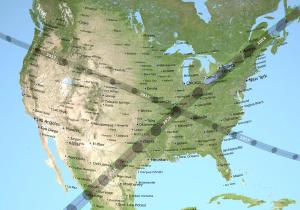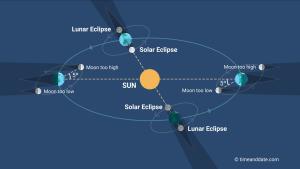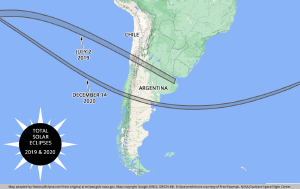Blog
Crisscross Applesauce
4 April 2024
 Ernest Wright/NASA’s Scientific Visualization Studio
Ernest Wright/NASA’s Scientific Visualization StudioA friend of mine was looking at the path of totality for the Great American Eclipse happening in a few days and noticed that it’s very different from the path of the 2017 eclipse. In 2017 it went from Oregon on the west coast down to South Carolina on the east. This year the eclipse traces a path from Mexico to Maine. The two paths cross in southern Illinois, and my friend wanted to know why. The answer has to do with the season in which each eclipse occurs.
We experience seasons because the Earth’s axis is titled about 23° from the axis of Earth’s orbital plane. This means that the path of the Sun across the sky shifts over a given year from higher in the sky to lower and back. It turns out that the Moon orbits the Earth roughly in line with Earth’s orbital plane. Its orbit is actually tilted about 5° off the orbital plane, which adds complications to eclipse calculations. It also means there are “seasons” to eclipses.
 Time and Date
Time and DateA solar eclipse can only occur when the Earth, Moon, and Sun are exactly aligned in the same plane. Because of the tilt of the lunar orbit relative to the Sun, most of the time the Moon passes between the Earth and Sun it is either too high or too low for an eclipse to occur. This is why solar eclipses don’t happen every month. When the Moon does line up for an eclipse, its orbit still affects the path of totality. If an eclipse happens in spring, then the tilt of its orbit means the shadow across the Earth shifts from south in the west to north in the east. If an eclipse happens during autumn, then it is the opposite, tracing a path from north in the west to south in the east. Since the 2017 eclipse was in August, it traced a downward path. This year’s eclipse is in April, hence the upward path.
 National Eclipse
National EclipseWhen solar eclipses happen in winter or summer, the paths are much more horizontal. You can see this in Chile’s 2019 and 2020 paths of totality. The 2019 event was in July and the 2020 in December, so they are more similar. That said, neither of these is exactly horizontal. Other factors such as the curvature of the Earth’s surface make it nearly impossible for eclipses to trace a truly horizontal path.
It all gets very complicated. But one of the things astronomers have long noticed is that eclipses follow a certain cycle of time. They are more likely to happen in spring and fall, and there are geometric patterns of the lunar orbit means there are recurring patterns such as the Saros cycle and the Metonic cycle.
Most people assume eclipses are rare, but because of the seasonal influence on eclipses, solar eclipses generally happen about twice a year. But you can only see a total eclipse in the path of totality, and that usually occurs far from home. So if you happen to live near the path of totality this year, do your best to get into the path come Monday. I can promise you it will be worth it.